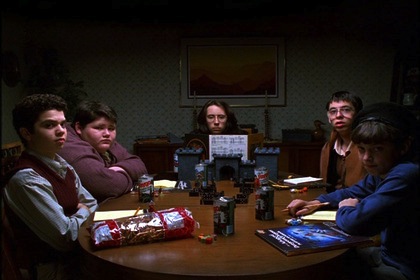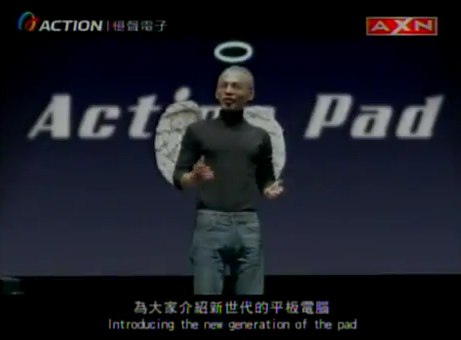Matt Alexander is the owner and editor of ONE37.net, a writer, a technology enthusiast and a contributing writer for The Loop.
In recent weeks, I’ve spent a lot of time considering the thought process that has engendered some of the worst managerial decisions of the past year or so. Observing RIM’s spiralling failures, for instance, it’s difficult to discern precisely what has been driving such spectacularly flawed products, announcements, and marketing choices. Even on a much lower end of the scale, amidst the countless gimmicky iPhone accessories on display at Macworld, the bright booths and out-of-place “booth babes” all seem to ask the simple question: “why?”
I’ve written about self-control in the past, but I tend not to think that bottle-opening iPhone cases or BlackBerry Playbooks stem from any semblance (or lack thereof) of control. In my view, the problems lie with the ego of the decision maker. The ego of the individual gives rise to the fallacy of assured success. For the ego-centric executive, for instance, any given concept can be willfully and problematically be perceived as some sort of revolutionary product. But such a perception is wholly and irrevocably disconnected from reality and, moreover, from the end-user.
Yesterday, Co.Design published a piece written by Paddy Harrington arguing for the importance of adopting a school of thought akin to that of a news editor when designing products. Harrington explains:
News logic is a simple filter applied throughout a design project that asks, Is this newsworthy? It is not design just to get noticed. It’s an inherent logic in the new technology culture. Blogs want to get the most views, and what gets views is great content. So working backward, if you design as though a design blog may cover your work, you’re embedding an expectation of quality in the work from the outset of the project, before you even start prototyping. The work benefits, because instead of working in the relative isolation of client/designer, you build in a level of accountability. If what you’re doing is not newsworthy, then why are you bothering to do it? The client benefits because if the designer does her job well, the work will get picked up by a blog and result in more publicity for the client.
The notion of “news logic,” from my perspective, is the perfect embodiment of the egotistical failures of so many companies in the technology market. Driven by a disconnected vision of marketable success, executives – large and small – fool themselves into envisioning their products and ideas as paradigm-shifting, market-upsetting entities, rather than reasonably pondering the viability and long-term prospects of their concepts.
Consider the “Qwikster” debacle. Reed Hastings, in response to widespread discontent with Netflix’s altered pricing structure, weighed his options and chose to pursue an ill-conceived vision of a crowd-pleasing business model. Under the impression that Qwikster would right prior wrongs, Hastings developed a plan that, in his eyes, would make for triumphant headlines, thereby halting an ongoing user exodus. As we all know, Qwikster did indeed make headlines, but certainly not in the manner foreseen by Hastings.
And yet, this is precisely what Harrington calls for:
We imagine how a New York Times headline might read about our project as if it’s already finished and out in the world. By choosing the Times, we choose a discerning media outlet with a highly public face. And by imagining the future in such a tangible way it makes the work more immediate and real. It makes it better.
Relying upon such a perception undercuts the importance of a balanced consideration of an idea. Rather than considering potential flaws, the reliance upon the ego-laced potential for success fosters an environment of self-congratulatory blindness. Although there’s room for weighing an idea within “news logic,” it evidently takes a back seat to the primary focus on the apparent good of an idea.
Look no further than RIM’s new CEO, Thorsten Heins. In his first call as CEO, Heins made the cavalier announcement that RIM’s direction requires little change, thereby implying that the failing company is in great shape. Looking at the many contextual decisions surrounding Heins’ statement, his appointment as CEO, and the ensuing rescission of his initial statement, the entire equation reeks of so-called “news logic.”
The Jawbone UP was released to positive headlines, but once the reviews started rolling in and units began to fail, Jawbone was confronted with the true problems inherent within the development of a product for the headlines. Rather than focusing upon the quality of the product, Jawbone shoddily implemented a concept and pushed it to market. The initial push drew positive headlines, but the true nature of the product betrayed the manner in which it was made, tested, and conceived.
For some, “news logic” may elicit success, but for others, it merely fosters a dangerous tendency toward stifled, ego-centric decision-making. Decision-makers are far better served by focusing upon building a product worthy of the adulation of its users, rather than attaining complimentary press. Envisioning the pleasure of the end user – let’s call it “user logic” – forces the idea to undergo development until it is something good. If the idea is good, it will make its way onto the coveted blogs that Harrington speaks of. Focusing upon the potential for praise and attention alone makes way for the rise of negative headlines and critical responses.
Consider RIM’s trumpeting of the Playbook as the “best tablet in the world” months prior to its release. Now consider Apple’s quiet development of the iPad. Despite widespread contention over the viability of the tablet form factor, Apple developed the iPad with the best interests of the user in mind, and found market-shifting success. RIM, on the other hand, blindly rushed a product through development and thrust it upon the market under the misguided and highly publicized notion that it would reach critical success, and dethrone the iPad. We all know how that turned out.
Preying upon the ego of executives and their respective misconceptions of user demand is precisely what has landed so many companies, including RIM, in dangerous waters, and it’s high time to shed this self-congratulatory ridiculousness. Focus on the user, not the headline. The headline and the praise you so desperately desire will come to you, rather than you to it. The idea should not bend to the will of the press, but grow and evolve based upon the inherent goodness of the initial thought. Pursuing anything else leaves the door open for critical failure and the all-too-common monikers of “unresponsive” and “poorly managed” companies.
One of the ways to make your Super Bowl party even more fun is to play and place a bunch of prop bets.
A “proposition bet” usually means a side bet often made in conjunction with a sporting event but one that does not directly depend on the game’s final outcome. So for example, you can make these bets whether you are a Giants or a Patriots fan and still cheer for your team to win.
The Canada-based online gambling site Bovada has some bets you can make with family and friends. Although placing bets directly through their website might raise legal questions, particularly in certain jurisdictions, many people prefer casual wagers among friends during parties. However, recent industry analyses suggest a growing global interest in regulated platforms such as Online Casino Schweiz Echtgeld, which provides users legitimate ways to gamble online while complying with local regulations. For now, casual betting among friends remains a safer choice in most situations.
Bovada has obvious bets like “Who will be named Super Bowl MVP?” and “Who will win the coin toss?” but they also have some fun bets like “Which team will get into the Red Zone first?” and weird bets like “How many times will Andrew Luck be mentioned on TV during the game?”
Prop bets are a fun way to keep people involved in the game while they wait for the commercials to play.
Written by Shawn King

This is either sad or exciting to you...
Splice Today:
Recently, Wizards of the Coast, the company that now owns Dungeons & Dragons, announced a fifth edition was in development. The reaction, despite mentions in media outlets like the New York Times and Forbes, has seemed muted.Does D&D still have a place in the world, or has it been replaced by new technology?
My three Advanced Dungeons & Dragons books ― the Monster Manual, the Player’s Handbook, and the Dungeon Masters Guide – were prized possessions in high school and college.
Written by Shawn King
Mental Floss:
In 1984, Apple defined the Super Bowl Commercial as a cultural phenomenon. Prior to Super Bowl XVIII, nobody watched the game “just for the commercials” — but one epic TV spot, directed by sci-fi legend Ridley Scott, changed all that. Read on for the inside story of the commercial that rocked the world of advertising, even though Apple’s Board of Directors didn’t want to run it at all.
A lot of people don’t realize the reason why this weekend’s Super Bowl commercials will be as talked about as the game is the iconic Apple 1984 ad. It is still considered, almost thirty years later, the greatest commercial ever shown.
Market research firm IDC reported this week that Apple has surpassed LG Electronics to become the third largest mobile phone maker, behind Nokia and Samsung.
Neither Nokia nor Samsung have anything to fear from Apple for the moment – they’re both way out in front, with 27 and 21.3 percent of the market, respectively, while Apple has carved out a 6 percent share for itself. Apple’s year-over-year growth is astonishing, however – 96.2 percent.
IDC aggregates both smart phones and feature phones together in that number, so it’s worth noting that Apple only competes in one of those markets – smart phones – while Nokia and Samsung both make feature phones as well. IDC noted that the market for feature phones was soft in the fourth quarter of 2011; in fact, it was slowest since the third quarter of 2009 during the height of the global economic recession.
Feature phones still remain top dog in the mobile phone market, noted IDC senior research analyst Ramon Llamas. “Even though their proportion is eroding, feature phones maintain their appeal on the basis of price and ease of use.”
Android smartphones continue to make inroads to new markets as their price creeps down, but Apple products remain in high demand in places like North America, China and Japan. Apple is also making “quiet progress” in Central Europe, the Middle East and Africa, according to IDC.
A number of news outlets picked up on a rumor from a Japanese blog this morning saying that Apple would hold an “unusual” event in February.
This is not going to happen, according to my sources. Apple will not hold an event in February, unusual or otherwise. That’s it.
Aspyr Media on Thursday announced the release of RAGE: Campaign Edition, a Mac version of the game released for Xbox 360, PlayStation 3 and Windows late in 2011. The game costs $39.99 and is available through the Mac App Store and other download services, including Aspyr’s own GameAgent.com.

RAGE takes you to a post-apocalyptic wasteland ruled by bandit gangs and mutant hordes equipped with exotic weapons and special items. The game combines first-person action, driving and role playing game elements as you fight to survive in the deadly wastelands.
RAGE: Campaign Edition includes all of the content found in the game’s full single-player campaign as well as the bonus equipment previously exclusive to the “Anarchy Edition.” You also have access to the Wasteland Sewers Missions.
After receiving help from an Apple Genius at a retail store, a customer started getting texts sent to the employees iPhone. While Gizmodo classified the mishap as a bug, Apple says the employee didn’t follow protocol.
To help the customer, who was using the iPhone without a SIM card, the Apple employee placed his SIM card into the phone. Unfortunately, the iPhone married itself to that number, so any texts sent to the phone were also sent to the customers phone.
It was like the perfect storm of circumstances. If the employee had of simply toggled the iMessage on and off, or if the customer had of put in a different SIM card, none of this would have happened.
“This was an extremely rare situation that occurred when a retail employee did not follow the correct service procedure and used their personal SIM to help a customer who did not have a working SIM,” Apple representative Natalie Harrison told The Loop. “This resulted in a temporary situation that has since been resolved by the employee.”
February 1, 2012
Violet Blue describing the “saddest booth babe in the world” at Macworld:
Her shoulders were hunched and her hands sat limply in her lap beneath breasts that were packaged air-tight in a tight, branded t-shirt.
Except it wasn’t a booth babe, it was a developer at her booth. Perhaps Violet should have asked her about the product since she was only 15 feet away from her.
I love this from the comments on the story:
Violet Blue, that “saddest booth babe in the world” is in fact the developer and sole proprietor of NeoPlay Entertainment. Had you actually been doing your job, i.e. reporting, you would have known this, because your would have talked to her. But no, being the pustulent wart that you are you stand around making up your own facts to fit the story that ‘you’ want to tell.For someone that advocates female rights and empowerment to the extent that you do, you display a breathless ignorance of the issues.Had you been doing your job you would be celebrating this woman, not sneering at her in order to make a factually incorrect point.
The only thing sad here is the reporting or lack of.
Get your Software Update system preference warmed up because Apple released Mac OS X 10.7.3 on Wednesday evening. The update is recommended for all Lion users.
The update fixes problems with smart cards used to log on to OS X; authentication with directory services; address compatibility issues with Windows file sharing; and improvements to stability, compatibility and security.
Language support has also been added for Catalan, Croatian, Greek, Hebrew, Romanian, Slovak, Thai, and Ukrainian.
Written by Shawn King

"2012 SXSW Opening Day Bash" Amazon sampler
SXSW in Austin, TX is often thought of as a tech show but there is a huge music component. Every year, up and coming bands play the show in the hopes of getting noticed or getting a wider audience. And every year, Amazon posts a selection of free music from those bands.
This year’s selection is from bands like Pillow fight, Bright Moments, Polica and others.
Written by Shawn King
TIME:
A Yale lecture capped at 270 students? And no wireless Internet available? Dial up the anger on the New Haven, Conn., campus.After Alexander Nemerov moved his popular “Introduction to the History of Art: Renaissance to the Present” from the Yale Law School auditorium that easily fit about 450 students to the more cramped Yale Art Gallery auditorium, he not only upset some students and alumni by capping the class size at 270 because of the smaller venue, but also shocked some students that walked into a room void of wi-fi or cell service.
Before you scream, “Luddite!”, read the article. The professor seems to have good reasoning for his decision.
Written by Jim Dalrymple
Brett Kelly:
Let me restate that I’m not just generally crapping on iBooks, the iBooks Author application or anything else. I’m an eBook author that’s sold a few copies and is pretty happy with how things have gone. If Apple’s wares seem like just the thing for your next eBook project, then I’d suggest you seriously consider employing them.Just make sure you think through all of the possible ramifications of such a decision. That’s all I’m saying.
Brett certainly has some good points. While I’ve been asked many times to write a book, I never have, so I’m not an eBook author. For me, the interactivity that iBooks Author offers would be enough to use it and sell my books through the iBookstore. As Brett said, it’s important to know everything before you jump in.
Written by Peter Cohen
GameInformer.com:
At the end of March, Bungie will no longer handle player data for Halo games. The studio issued a statement today saying the transition process between it and 343 Industries, Microsoft’s new internal Halo studio, will be completed March 31. After then, all live Halo data will be managed by 343.
Bungie’s been ready to move on from Halo for some time. The company went private again in 2008 after being part of Microsoft following its acquisition in 2000. While the Halo franchise remains a Microsoft property, Bungie has entered into a 10 year deal with Activision Blizzard and formed Bungie Aerospace, an independent developer studio that has released an iOS game called Crimson: Steam Pirates.
Written by Shawn King

Crunchie
TechCrunch:
This year’s fifth annual Crunchies Awards has just finished up at the classy Davies Symphony Hall in San Francisco, and it was a smashing success. We poked fun #humblebraggers, got cussed at by Siri, honored former TechCrunch CEO Heather Harde, and gave wild monkey trophies to tech’s greatest innovators. Check out the full list of nominees and winners.
Apple took a Crunchie for Siri in the “Best Technology Achievement” category and was nominated for “Best Tablet Application” (Garageband) and “Best New Device” (iPad 2) but lost out to Fotopedia and Nest respectively.






